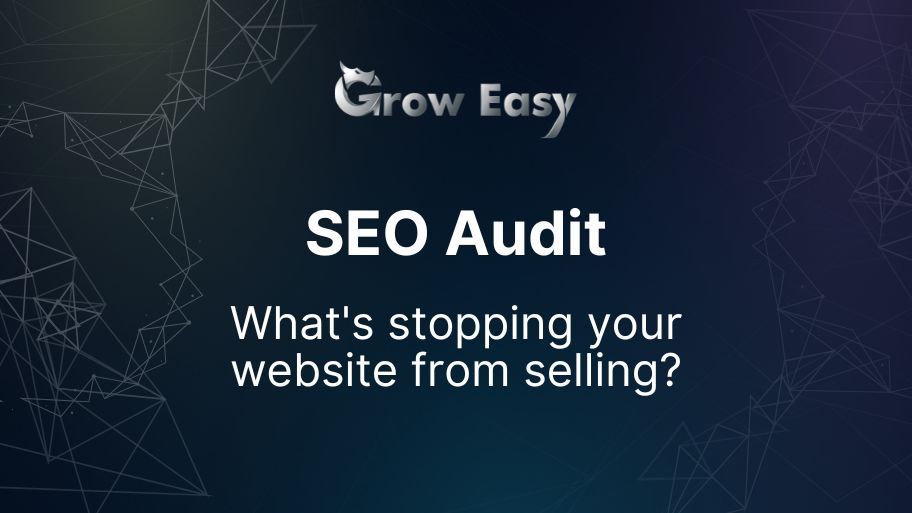An SEO audit is like a diagnostic of how many people are finding your website and which keywords they are searching for in search engines - Google, Bing, Yahoo and others. It shows what's working well and what can be improved to appear more often in search results.
The truth is simple: if your website is not SEO optimized, it's like having a store on a dark street without a sign. An SEO audit is the way to help you shine a light down the dark tunnel of search engines so customers can get to you - clearly, easily and confidently.
It's a process that will show you exactly what's not working, where you're losing leads, and how to turn things around in your favor. In this Grow Easy article, you'll learn what a good SEO audit includes, what the most common mistakes are, and how to fix them to turn your website into a real sales machine.
Find out more ** NOW** what you need to check and how to fix your online business's brakes!
Content:
1.Why is SEO audit important?
2.Major problems that stop your website from selling
3.SEO Checklist: What to include in your analysis
3.1 Point 3 and 4: Technical basics that affect your rankings
3.2 Point 5 and 6: What to include in your analysis
3.3 Point 7 and 8: SEO controls on URLs
3.4 Point 9, 10 and 11: Internal optimization
3.5 Item 12 and 13: SEO controls after the audit
3.6 Item 14 and 15: Final pieces of the SEO puzzle
4.Regular SEO audit = increased revenue
5.Do you need to do an SEO audit every day?
5.1 SEO audit is not a waste of time
Why is an SEO audit important?
In the digital environment, competition is huge and search engine algorithms are constantly changing. One of the main contributors to this, in the world's largest search engine, are so-called Google updates - regular updates to the algorithms by which Google evaluates and ranks content.
Some of these are more subtle, but a few times a year there are major (core) updates that can significantly shift your position in search results. This is why the Google example is illustrative, even if your website is well positioned, you are not immune to such changes. In such a context, an SEO audit isn't just good practice - it's a necessity.
Without it, you're leaving hidden problems that literally pull your website back in the search engine pages even when you have quality content or an advertising budget.
This process identifies errors that are likely to prevent good Google rankings. It also identifies opportunities that will increase your website's visibility to rank at the top of search.
If you're working with a digital agency, an SEO audit is a starting point for any long-term strategy that will give you a clear picture of where you stand and what you need to improve.
The result: better positioning, more organic traffic and a real improvement in your business results.
Major problems that stop your website from selling
You can invest money in expensive web design, but if the keywords aren't in the right place - you simply won't be seen. The reason usually isn't in the design, it's in the invisible obstacles that an SEO audit will easily find.
Here are the most common:
- Your website loads very slowly - The three-second rule applies here - users expect your website to load quickly, otherwise they'll just leave without even seeing what you're offering. Do a technical check and optimise your images, code and hosting. In an SEO audit, this is one of the first things we check.
- Your content is not optimized - Without clear titles, keywords, and well-structured text, you'll make it difficult not only for users, but also for search engines to understand your website. In this case, we review the content and adapt it to meet the searches and needs of users and algorithms.
- Navigation and user experience (UX) are not good for you - When navigation is confusing, sales drop dramatically. This is where we recommend putting yourself in the customer's shoes. Build the path to order so that it's intuitive and fast.
- You have technical errors - Broken links, duplicate content, pages that don't index are problems that often remain hidden but have a strong negative effect on SEO results. An SEO audit will bring them to light and get concrete solutions.
- You lack quality external backlinks - If other authoritative sites aren't pointing to yours, Google will have a hard time trusting you. That's why part of the process includes a link profile analysis and a strategy to attract strong backlinks through content, partnerships or digital PR that creates link building.
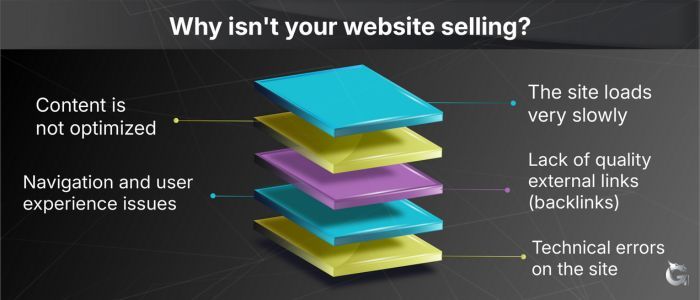
SEO Checklist: What to include in your analysis
# 1 Mobile-friendly website
A mobile-friendly feature is extremely important. Do you know why that is?
According to Google, more than 60% of traffic comes from mobile devices. Google has started following the mobile-first algorithm. And that means it's going to start pushing websites to the top positions that follow best practices for indexing using this method.
The question is, how do you check if your website is mobile-friendly?
Use Google's Mobile App Testing Tool to find out. It will show you whether your website is mobile-friendly or not.
# 2 Google only indexes one version of your website
Did you know that Google can see several different versions of your website - with www, without www, with http, with https and more. If this isn't controlled, indexing will get scattered between them, and this confuses both search engines and users.
That's where Google Search Console comes in - your indexing control center. Log in and make sure you've added and verified only one major version of your website. This should be your canonical domain - the only one you want Google to follow.
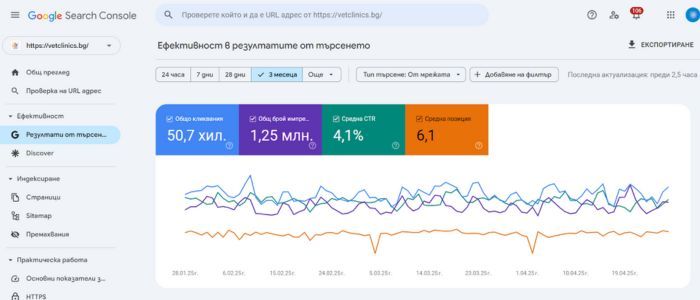
Point 3 and 4: Technical basics that affect your ranking
# 3 Website Speed
Most users are impatient and don't want to wait long - Google understands this best. If your website pages load slowly, then users will go to a competitor's website. This is one of the major reasons you need to address to prevent customers from leaving your website.
Speed isn't just a matter of convenience, it's also a matter of trust and ranking on Google. Use the GTmetrix tool to find out where you currently stand. It will analyze your website loading speed and show you:
- Which resources are slowing down the page - images, scripts, external elements
- Total load time
- Evaluation of performance and recommendations for improvement
Once the analysis is done, pay attention to the items marked in red - they are the most problematic.
Tip from Grow Easy: Optimize images, minimize CSS and JavaScript files, and consider faster hosting if GTmetrix shows server-side slowdowns.
# 4 Crawl the website
The next important thing to do is SEO crawl your website. SEO crawling is a process that simulates the way Googlebot (Google's bot) "crawls" your website and scans the content. It's a way for search engines to understand what's on your pages, which links lead where, and whether everything is working as it should.
The easiest method to do a crawl is with a tool like Screaming Frog. Simply enter the URL of your site and the software will scan each page. This tool will show you what's working, what's missing, and where Google's obstacles are hiding.
Point 5 and 6: What to include in your analysis
## 5 Duplicate Content
Duplicate content includes duplicate meta tags, descriptions, text on different pages, header meta descriptions, copied content from other sites, and more.
What you can do in this case:
- Review and rewrite repeats - Even small changes can make for unique content.
- Set canonical tags to show Google which version of the page is leading.
- Use Google Search Console to find problem pages.
- Block indexing if you need to keep some duplicate pages - Do this via a robots.txt file.
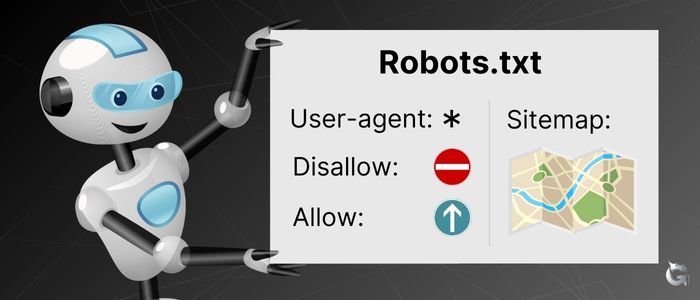
# 6 Detect and fix indexing problems
Now is the right time to find out if your pages are indexing or not. To do this, use Google Search Console to see:
- How many pages have been submitted for indexing and how many of them are actually indexed.
- Which pages are blocked, rejected or have errors.
- Indexing status in the "Pages" (or "Pages") tab.
Item 7 and 8: SEO control over URLs
# 7 URL Parameters
Sometimes the Google crawler crawls the same page twice - once with parameters in the URL and once without. You need to add URL parameters to the Google search console to avoid this and tell it that it is crawling the same page.
The solution is easy: Tell Google what the "real" version of the page is by adding a canonical tag. This is a small piece of code that is placed in the HTML part of the page.
As a result, Google will know that this is the primary address and ignore the other parameter options.
If you use parameters like WordPress does with plugins like Yoast, you can do the whole thing in just a few clicks - no code, no drama.
# 8 Check redirects
According to statements from Google representatives like John Mueller and Matt Cutts, Google can follow up to 5 consecutive redirects in a single crawl. Therefore it will not reach your landing page.
Redirects (or redirects) are like road signs for Google and users. Think of it this way - you click on a link, but instead of taking you directly to the page, it sends you to another page, and another, and another - a chain redirect.
Chain redirects can eat up crawl budget and prevent the final page from being indexed. So try to limit redirects to avoid this problem.
Check for chained redirects using an tool like Ahrefs's Redirect Checker or Screaming Frog. Redirect directly from the first page to the last.
Point 9, 10 and 11: Internal optimization as part of SEO audit
Once you've analyzed your website, check individual pages for insufficient content, title tags, meta descriptions, permalinks, etc. It's hard to optimize every single page, but you don't have to, just focus on the core 5 pages.
You can do this, through the tools:
- Screaming Frog - Analyzes site structure, shows missing tags, duplicate content and issues.
- Ahrefs - You will see which pages need optimization.
- Google Search Console - Will tell you which pages have low CTR or technical issues.
10 Website Hierarchy Analysis
A good website structure is like a map for Google and users. If your hierarchy is clear - for example, a main menu with categories and subcategories that is easy to follow - Google will crawl your pages better.
# 11 Identify weak content and orphaned pages
Orphan pages are those that lack internal links and have no value. This, in turn, makes it difficult for Google to find and index them. For example, if you have a page about a certain product or service, but it's not linked to any other pages or categories, that page may be orphaned.
The solution to this is to link it to main categories or other pages - for example, add a link to it from relevant categories or other products.
Point 12 and 13: SEO control after the audit
# 12 Website links check
Hierarchies are extremely important for SEO and for this both external and internal links should be checked. If any of your pages don't exist, it leads to "broken" links.
For example, when moving a product from one category to another, with the old link remaining active, users will get a 404 error.
To prevent this, regularly check internal and external links using a tool like Screaming Frog. It will help you find broken links and fix them.
# 13 Using website analytics and metrics
Once you're done with the SEO audit process, use tools like Google Analytics 4 to see if any pages you've changed are getting traffic and if there's an increase in their rankings.
For example, if you have already improved the content of important pages, check if there is an increase in visitors after making these changes.
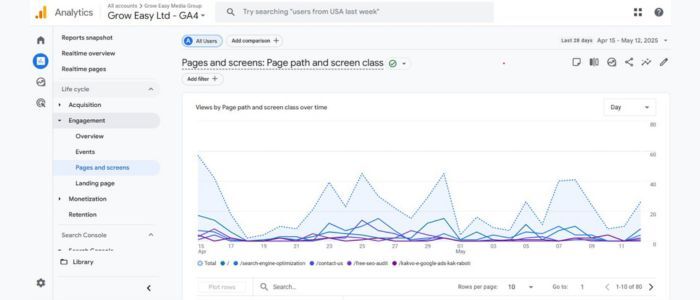
Item 14 and 15: Last pieces of the SEO puzzle
# 14 Backlink Analysis
Backlinks show Google that your content is valuable and deserves a higher position - essential in a technical SEO audit. For example, if a tech blog links to your site for a new product, that's a signal to Google that your content deserves a high position.
#15 UI/UX problems that stop sales
SEO is not limited to keywords and links. If it's not easy for a user to navigate your site to perform the desired action, your efforts won't work. UI/UX troubleshooting means putting yourself in the user's shoes and finding out what is possibly stopping them.
Use tools like Hotjar or Microsoft Clarity to see what your site visitors' experience is like and exactly where they're stumbling.

Regular SEO audit = increased revenue
With an SEO audit, you won't just do a technical check, you'll build a shortcut to real results. When you eliminate barriers to users and search engines, traffic not only increases, but it starts to convert into real customers.
Through a quality SEO audit, you'll discover what's stopping people from taking the action you want them to take - whether it's a slow website, difficult navigation, or a lack of a clear message in your content. Once you find and fix the mistakes you find - you'll reach the right audience, increase organic traffic and convert visitors into customers.

The results don't magically appear, they come from removing the brakes and creating a better experience for the user. In other words, a professional SEO audit doesn't just bring you more visitors, it turns them into real customers.
Should you do an SEO audit every day?
SEO is fluid and dynamic and requires regular adaptation to new trends and algorithm updates to stay competitive.
Constant changes in SEO can affect your Google rankings, and in order to take advantage of them, you need to do a regular SEO audit. These changes require periodic adjustments to your site's content, tags, links and structure, which can be a complex and time-consuming process.
This is why a systematic SEO audit is essential. To be at the top of Google results you need professional help focusing on all these details.
Don't leave success to chance! Trust an expert and do a FREE SEO audit now!
SEO audit is not a waste of time
If you want your website to sell and not just be an online business card, an SEO audit is a must step. It will not only find out what the problems are that are holding you back, but it will also give you direction towards real improvements in performance, traffic and sales.
SEO isn't a spur of the moment strategy - it's a success formula that works for you 24/7.
SEO audit = better rankings + more traffic + more sales
Ready to get your website working for you?
Reach the right audience with Grow Easy! Contact us for a free consultation today!
